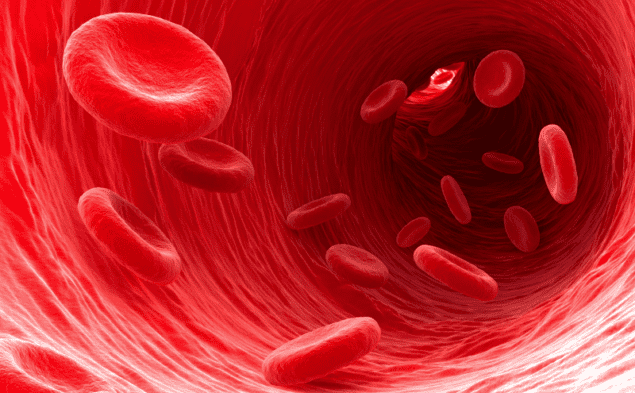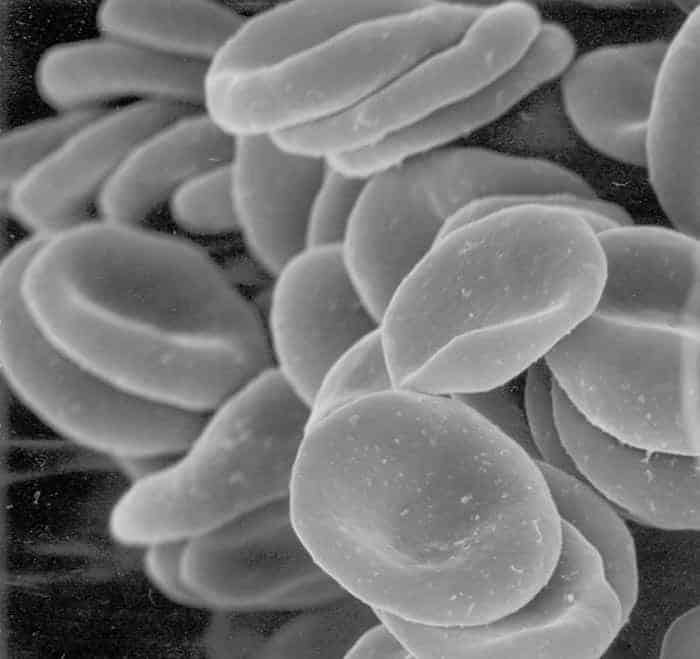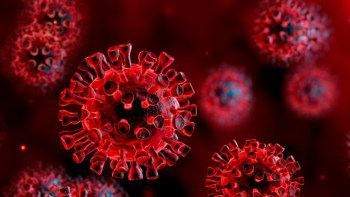
The shape of red blood cells depends on where they are in the body and now researchers in Germany and France have used microfluidics in combination with numerical simulations to gain important new insights into how this shape-shifting occurs.
Red blood cells are disk-like objects with diameters of about 8 microns and account for almost half of the blood’s composition. At rest, the cells have a symmetric biconcave-disk shape that is thicker at the edge than in the centre (see figure).
They are not rigid particles and comprise a liquid cytoplasm that is encapsulated by a membrane, making the overall cell structure flexible. As the cell travels through the body, it flows through wide arteries and veins, but can also negotiate narrow vessels. All the while, the cells are immersed in relatively thick and viscous blood plasma – which can affect their shape.
Shape and mobility
The deformation of blood cells during their journey through the body plays a crucial role in their mobility and affects how blood circulates. Therefore, understanding how shape affects mobility is crucial to understanding basic blood circulation, some blood-related diseases and how drugs move through the body.
Scientists know that red blood cells undergo shape transformations in narrow blood vessels due to the presence of shear stresses. With increasing shear rate, the cells first tumble and roll, then change into a tumbling and rolling “stomatocytes”, which are reminiscent of an asymmetrical parachute. At higher shear rates, red blood cells form exotic multi-lobed shapes.
Now, Dmitry Fedosov and colleagues at the Institute of Complex Systems at the Research Center Jülich and the University of Montpellier have looked at how transitions between various red blood cell shapes depend on a wide range of shear rates and viscosity ratios between the cell’s cytosol (the fluid inside a cell) and blood plasma.
Fedosov says that the team’s study, “aimed to explain the basic behaviour of red blood cells and their possible shapes and dynamics from the physics point of view”. He adds, “We already understand how these cells behave in simple flows; understanding their movement in more complex flows within the microvasculature represents the next step”.
Tiny channels
To explore the behaviour of red blood cells under physiological conditions, one needs to apply high shear rates with relatively strong flows. However, working with water-like solutions in a conventional rheometer at high shear rates would be very difficult from the experimental point of view. This is because the solution may not be viscous enough to remain within the fluid chamber. Fedosov and colleagues overcame this limitation using microfluidics, which involves moving fluids through tiny channels.
The researchers obtained red blood cells from fresh human blood. The cells were then diluted in a viscous fluid and passed through a slit-like rectangular channel. The shapes and motions of the cells were recorded using a microscope equipped with a high-speed camera. As the team increased the flow rate within the microfluidic channel, the cells started to change shapes from something resembling a rolling doughnut to multilobed structures.
The observed shapes and dynamics were exactly in line with predictions made by 3D simulations that were done using two different hydrodynamic techniques.
Future steps
The research group plans to continue the investigation and make connections between the dynamics of red blood cell shapes and their pathological changes in various diseases. Fedosov explains, “we want to go to more complex geometries and realistic blood flow conditions. In reality, blood is a little bit denser than what we have simulated.”
“Theoretically, it should be possible to apply our findings to blood cells in different diseases. For example, we have already worked on malaria. It should also be possible to explore sickle cell anaemia. We could create a model system, which mimics changes in blood cells in these diseases, for studying their behaviour in flow and the effect on oxygen delivery,” he adds.

Why blood cells move in slippers
Timm Krüger of the University of Edinburgh told Physics World that an important strength of the research is that it “used two different and quite different modelling approaches along with an experiment”.
He adds, “In order to model complicated systems of red blood cells in larger vessels, we need information about the single cell behaviour”. The work of Fedosov and colleagues provides that information and Krüger says it “can be used as input for more advanced models”.
Krüger also foresees potential applications in medical diagnostics. “Some diseases, such as malaria or sickle cell anaemia, affect the shape of red blood cells. Understanding the flow behaviour of [red blood cells] better could hypothetically lead to improved diagnostics from a small amount of blood.”
The research is described in Physical Review Letters.



